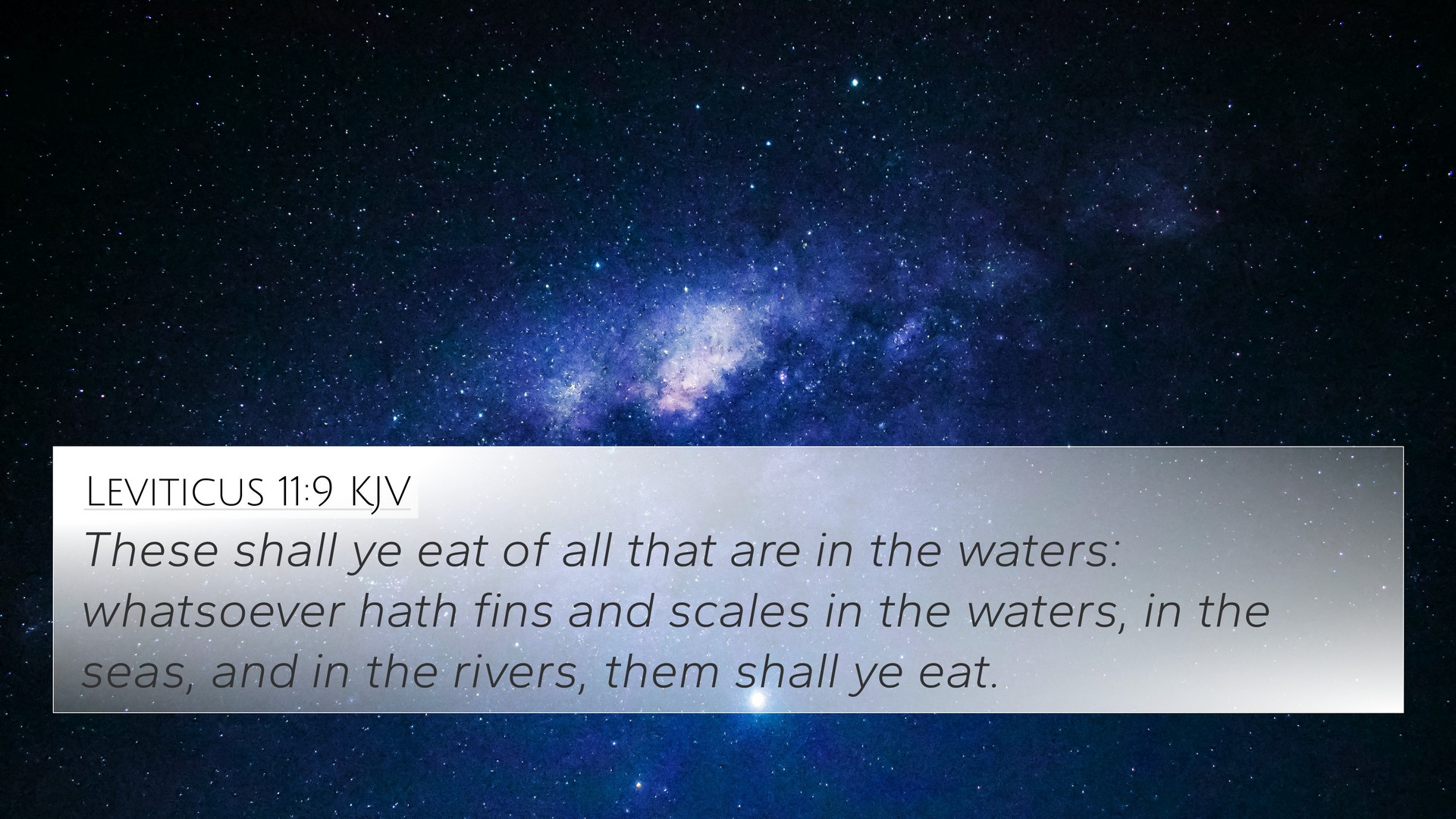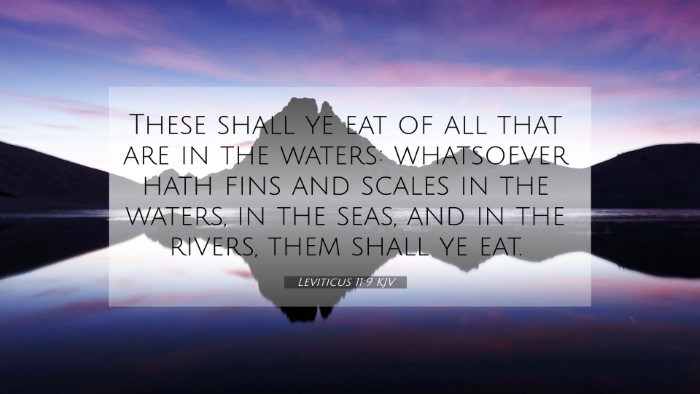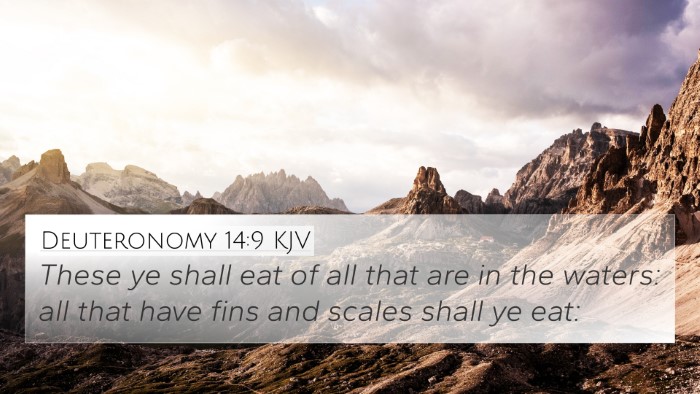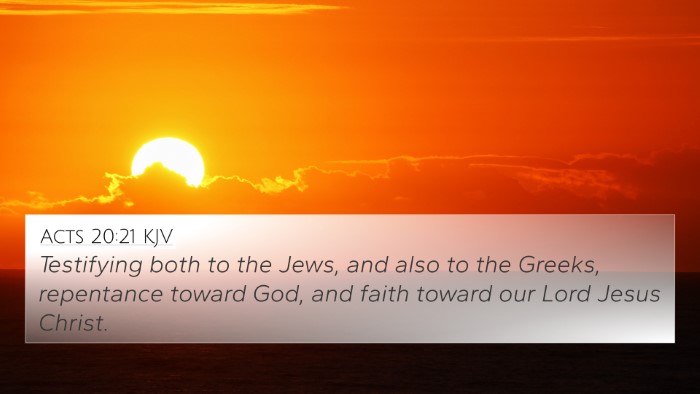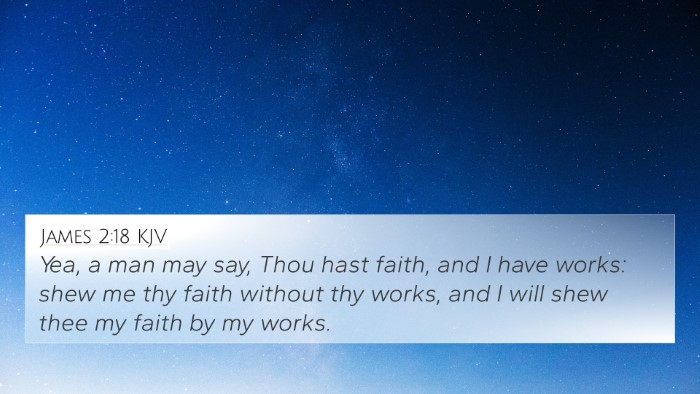Understanding Leviticus 11:9
Leviticus 11:9 states:
“These you may eat of all that are in the waters: whatever has fins and scales, whether in the seas or in the rivers, that you may eat.”
This verse is part of the dietary regulations given to the Israelites, outlining which creatures from the waters are permissible to eat. The emphasis here on fins and scales serves as an important distinction in the Law of Moses, surrounding notions of purity and cleanliness in dietary customs.
Commentary Insights
In exploring the meaning of this verse, we can draw from various public domain commentaries:
Matthew Henry's Commentary
Matthew Henry emphasizes that this directive not only establishes dietary restrictions but also represents God’s care for His people by providing guidelines that lead to health and holiness. This symbolization aids in distinguishing between clean and unclean, which forms a larger narrative about spiritual purity.
Albert Barnes' Notes on the Bible
Barnes outlines that the distinction between clean and unclean creatures serves as a deeper lesson on separating the sacred from the profane. He notes that these regulations are not merely for physical sustenance but also serve a didactic purpose in holiness and obedience to God as foundational aspects of Jewish identity.
Adam Clarke's Commentary
Clarke highlights the inclusivity found within these rules, focusing on the bounty of acceptable creatures. He implies that this classification not only pertains to the Israelite community but sets a precedent for developing discernment regarding spiritual and moral choices in broader life contexts.
Thematic Connections
The dietary laws can be linked to broader theological themes, emphasizing the sanctity of God's Creation and our responsibility as believers to observe divine commandments. Below are key themes arising from this verse:
- Holiness and Separation: The requirement to distinguish between clean and unclean reflects the calling of all believers to maintain holiness.
- Symbolism of Purity: The concepts of fins and scales evoke imagery of purity, akin to how believers should present themselves spiritually.
- Divine Provision: Such laws reveal God's provision and concern for their well-being, both physically and spiritually.
Bible Verse Cross-References
To enhance understanding of Leviticus 11:9, the following related scriptures provide additional context:
- Deuteronomy 14:9-10: Reiterating the dietary laws with specific emphasis on clean animals.
- Ezekiel 47:10: Highlighting the abundance of fishing in promised land imagery.
- Matthew 15:17-20: Jesus’ teaching on what defiles a person in contrast to ceremonial laws.
- Acts 10:12-15: The vision of Peter revealing that all creatures can now be considered clean under the New Covenant.
- 1 Timothy 4:4-5: Affirmation that everything created by God is good and nothing is to be rejected.
- Romans 14:14: Reflection on how nothing is unclean in itself, reinforcing the New Testament perspective.
- Genesis 1:29-30: God’s original provision of food for humanity places importance on dietary choices.
Conclusion
The guidelines laid out in Leviticus 11:9 serve not only as instructions for the Israelites but as a foundational principle for understanding God’s character in relation to His chosen people. They establish a pattern for discerning God’s commands and their role in personal and communal holiness.
Utilizing tools for Bible cross-referencing can expand one’s understanding of interconnected themes within Scripture, revealing a rich tapestry of God’s wisdom and the inter-Biblical dialogue that enriches the faith journey.
Additional Resources
For those seeking to explore the connections between various Bible verses, utilizing a Bible concordance, a Bible cross-reference guide, or engaging in in-depth studies can provide insights into the vast web of scriptural relationships.
